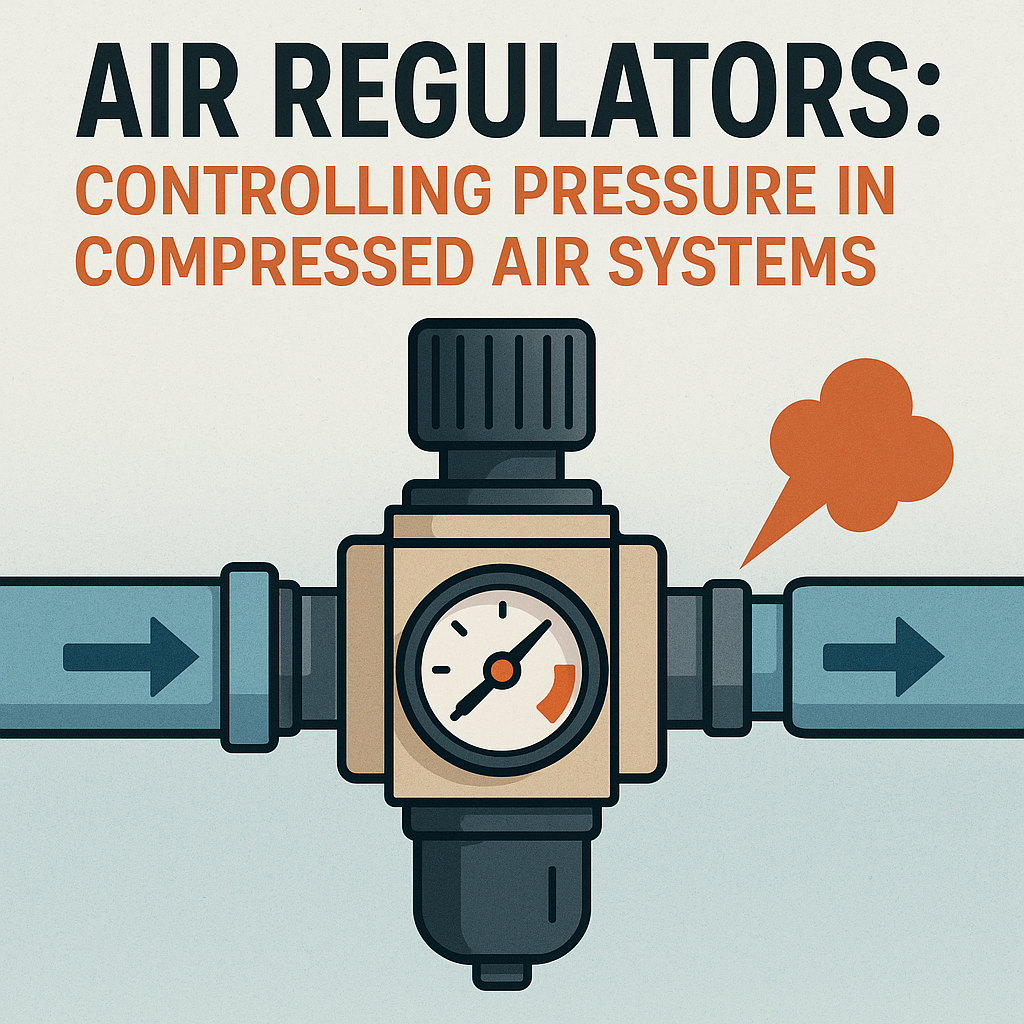
In compressed air systems, pressure is power. But without control, that power becomes unpredictable–and expensive. That’s where the air regulator comes in. It’s one of the most overlooked yet critical components in any pneumatic setup.
Whether you’re managing high-speed automation or running basic air tools, a reliable air regulator keeps everything running smoothly, safely, and efficiently. No one wants a system that sputters, surges, or wears down faster than it should.
So, what exactly does an air regulator do, and why is it so essential in pneumatic systems? Let’s break it down.
What Is an Air Regulator?
An air regulator–also sometimes called a pressure regulator–is a device that controls and stabilizes the pressure of compressed air as it moves through a pneumatic system. It sits between your air supply (like a compressor) and your pneumatic tools or actuators.
Its main job? Reduce the incoming air pressure to a desired level and maintain it, regardless of changes upstream or downstream.
Imagine your compressor is pushing air at 120 PSI, but your equipment only needs 60 PSI. Without a regulator, that excess pressure could damage tools, waste energy, or create inconsistent results. The air regulator steps in to deliver exactly what your system needs–and nothing more.
Why It Matters: The Real-World Benefits of Air Regulators
It’s easy to underestimate the value of something that just “controls pressure,” but air regulators have a measurable impact on performance, safety, and cost. Here’s why they’re absolutely essential:
1. Protects Equipment and Components
Too much pressure can wreak havoc on pneumatic tools, seals, and actuators. Valves can leak, fittings can loosen, and precision instruments can break down much faster. By keeping pressure within the recommended range, air regulators extend the life of your components and reduce downtime.
2. Improves Efficiency
Running tools at higher-than-needed pressure doesn’t give better results–it just wastes energy. In fact, reducing system pressure by even 10 PSI can cut energy use by 6–8%. Over time, that adds up to significant savings.
3. Delivers Consistent Performance
Air regulators ensure that your tools and systems receive a steady, reliable flow of pressure–even if the compressor output fluctuates. That means smoother motion, fewer system errors, and better product quality.
4. Enhances Safety
Surging pressure isn’t just inefficient–it can be dangerous. A regulator helps prevent sudden spikes that could cause hoses to whip, components to burst, or processes to go out of control.
Types of Air Regulators (and How to Pick the Right One)
Not all air regulators are created equal. Choosing the right one depends on how your system operates and what kind of control you need.
1. Relieving vs. Non-Relieving Regulators
-
- Relieving regulators can vent excess downstream pressure back into the atmosphere. These are ideal for systems where pressure might build up due to reduced demand or shutdowns.
- Non-relieving regulators don’t vent. They’re better for applications where releasing air into the environment isn’t acceptable (e.g., in cleanrooms or hazardous environments).
2. Single-Stage vs. Multi-Stage Regulators
-
- Single-stage regulators drop pressure in one step and are suitable for most general-purpose pneumatic systems.
- Multi-stage regulators allow finer control and are often used in sensitive or high-precision operations.
3. Manual vs. Precision Regulators
-
- Manual regulators are adjusted by hand using a knob or screw.
- Precision regulators offer tighter pressure control and may be designed for highly sensitive applications like instrumentation or medical devices.
Best Practices for Using Air Regulators in Pneumatic Systems
Getting the most out of your air regulator isn’t just about picking the right type–it’s about installation, positioning, and maintenance.
-
- Install regulators as close to the point of use as possible. This reduces pressure drop caused by long piping runs.
- Use a filter before the regulator to protect it from oil, water, and particles.
- Set pressure based on the tool’s requirement, not the compressor’s output. Overpressurizing doesn’t help–it only harms.
- Regularly inspect and recalibrate if needed. Pressure drift over time can cause regulators to underperform or lose accuracy.
Also, remember that air regulators work best when paired with other air preparation components, like filters and lubricators. Together, they form what’s known as an FRL unit (Filter-Regulator-Lubricator)–a smart way to keep your air clean, dry, and properly pressurized.
The Bottom Line
In compressed air systems, consistency is everything. The air regulator may not be the flashiest part of your setup, but it’s one of the most important. It quietly ensures that everything runs as it should–without waste, wear, or surprises.
If your pneumatic system seems overworked, underpowered, or just unreliable, it might not be the compressor’s fault. It could be a matter of improper pressure control.
